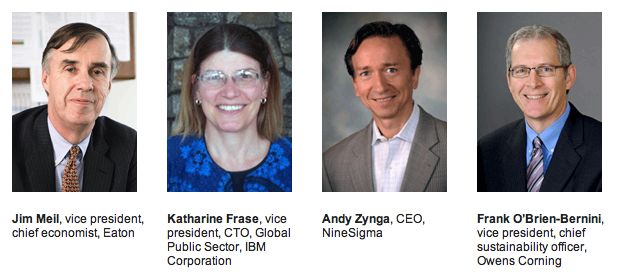
“Technological progress” fertilizes economic growth—and at a much higher level than investment in capital or labor does. According to the economic theories of Nobel Prize winning economist Robert Solow, a limited amount of economic growth can be attributed to factors such as increased production capacity or more labor. The rest of the growth—up to 85%—comes from new abilities to make new things, which creates new wealth. In other words, manufacturing driven by innovation. (Read more about Solow’s theories in this CTT post, also from today.)
Those in business and manufacturing understand that innovation keeps them in business every bit as much as Six Sigma methods do. You’ve got to be very good at what you already do, but you also get the largest payoff for being the first out with an innovative product or service.
Innovation, though, is not cheap. Companies must strategically position financial, production, and human resources. Large companies have C-level staff to analyze the business and technological climate and develop investments in new products and services.
Twenty or so of these C-level executives from leading, innovative companies are speaking at the ACerS Ceramic Leadership Summit in Baltimore, April 7–9 on the theme, “Where business and manufacturing meet strategy.” These speakers will share their views of the business climate, technological climate, emerging opportunities—all through the lens of manufacturing businesses. Nobody has a crystal ball for predicting the direction the economy, but these leaders know the signs and how to navigate the inside track.
Headline speakers include
Jim Meil, vice president and chief economist, Eaton Corp.
“Perpectives on Manufacturing: U.S. Competitiveness Today, and Prospects Ahead”
Katharine Frase, vice president and CTO, IBM Corp.
“Technology Trends”
Andy Zynga, CEO, NineSigma
“Strategic Open Innovation—Connecting with the Outside World to Advance Your Company’s Technology and Product Innovation”
Frank O’Brien-Bernini, vice president and chief sustainability officer, Owens Corning, Inc.
“Sustainability—The Path to Wealth Creation”
Al Lubrano, chairman, NAM Small to Medium Manufacturers and president, Materion Technical Materials
“Manufacturing in the United States of America… A Vehicle for National Economic Prosperity”
Greg Morris, lead, strategy and business development for additive technologies, GE Aviation
“Additive Manufacturing Technologies”
Panel discussion: “Finding and Developing Engineering Talent”
Eric Urruti, vice president of research and technology, Schott North America
Lora Cooper Rothen, CEO, Du-Co Ceramics Company
Allen Kimel, associate head for undergraduate studies, Pennsylvania State University
Wayne Butscher, program director, Baltimore Biotech Institute
Recognizing that the way these overarching trends apply in reality is complex, the second day of the meeting breaks into two tracks: Innovation, and Manufacturing and Workforce Sustainability. Here speakers will address issues like innovation strategies, patent law in 2014, manufacturing trends, regulation, expanding abroad, disruptive innovation, and building a workforce. I’ve listed them below, however, more speakers are being recruited daily. See the website for the full program.
The summit includes panel discussions and plenty of networking opportunities. Come with questions; leave with answers. This unique meeting will give you the information you need to strategically position your company for growth.
Anyone involved in manufacturing and innovation should be at the summit. The context is manufacturing of ceramics and glass, but the challenges and opportunities apply broadly.
Early bird registration runs through March 7, 2014. Don’t miss this event!
Innovation track speakers
Marty Curran, executive vice president and chief innovation officer, Corning, Inc.
“Innovation Strategies to Leverage Your Business”
Steven Ritchey, partner, Thompson Coburn LLP
“Patent Law in 2014: Act Fast or get Left Behind”
Anthony Nickens, vice president, Ceramatec, Inc.
“Ecosystem Approach to Disruptive Innovation”
Manufacturing and Workforce Sustainability track speakers
Dan Tipsord, director of engineering, Trans-Tech, Inc.
“Maximizing the Benefit of Manufacturing Outside the United States While Protecting Intellectual Property”
Bud Cass, managing member, Cass Consulting LLC; former president and chair, Advanced Cerametrics
“The Plusses and Minuses of Expanding Outside of the US. Where? Why? And When?”
Petra Mitchell, president and CEO, Catalyst Connection
“The Resurgence of Manufacturing Including Four Trends You Should Not Ignore”
Richard Norment, executive director, National Council for Public–Private Partnerships
“Public–Private Partnerships to Build a Competitive Workforce”
Richard Brow, Curators’ Professor of Ceramic Engineering, Missouri S&T
“A New Role for The American Ceramic Society: Educating Engineers Before and After that First Job”
